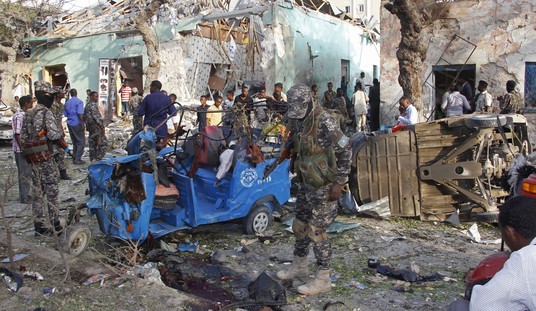Wired says one of major problem with the Afghan campaign is that much of the combat originates and happens outside it. Proxy assets in Pakistan, run by covert American programs, attack enemy forces in Pakistan and elsewhere. If the President cannot find an exit strategy it may be because much of the “war in Afghanistan” is already outside it.
[youtube mhVPpnUycSk?fs=1&hl=en_US]
Using proxies to fight enemy franchises was a familiar feature of the Cold War. The over-the-fence operations described in the Washington Post’s recent article about the cross border operations may have a familiar ring to them. Indigenous troops trained by the CIA, operating from bases on the border, supported by aerial assets, are unleashed on targets too sensitive to acknowledge fighting. But they are fought anyway.
From Niger to Yemen to Pakistan itself — and in places all across the globe — the administration is fighting against an unacknowledged and loosely organized global force while openly engaged in only one place: the “war of necessity” in Afghanistan. The notion that America is only in conflict with a bunch of Islamic apostates and fighting ‘to end it where it began’ is an inaccuracy bordering on falsehood. The Christian Science Monitor gives some flavor of its character in Pakistan.
According to US estimates, there are about 2,000 Al Qaeda militants in the region. Their main hideouts, the prime target of US drones in the spring, are located in the mountains between Miramshah and the Afghan border. Additionally, there are Uzbeks, Chinese Uighurs, Chechens, and Tajik militants collaborating in North Waziristan.
It is estimated that around 3,000 Uzbeks (not to mention a number of militants belonging to other Central Asian states) have taken shelter in the region.
Since last year’s killing of Tahir Yledeshev, chief of the Uzbekistan Islamic Movement, there have been splinters, but Uzbeks mainly fight alongside TTP leaders.
There is also a group of hundreds of militants belonging to the East Turkestan Islamic Movement (ETIM), a separatist extremist movement of Uighurs fighting against China for the independence of Xingjian Province. The commander, known as Abdul Shakoor, succeeded Abdul Haq al-Turkestani after he was killed in a drone attack early this year.
Even Afghanistan were somehow stabilized Pakistan and the surrounding areas would continue to be a problem. The area from which “al-Qaeda can find safe haven to plot and kill more Americans” goes far beyond the formal Afghan border. What is almost totally absent from the administration’s public strategy are plans to defeat the wellsprings of the enemy strength: countering its ideology, deterring its state sponsors, drying up its sources of funds. Addressing these larger issues would require acknowledging that Afghanistan is merely a small piece in a larger, generation conflict resembling a New Cold War. A New Cold War not against a nuclear power, but against powers America is waiting to become nuclear.
How such a conflict should be fought should be a matter for national debate. What methods of diplomacy, cultural conflict and judicious application of force are best be used can be a subject for dispute, but the necessity of their objects should not. However, this in turn would require naming an enemy, and building a coalition against it across party lines for a multi-decade effort.
That is an act of high statesmanship unlikely to proceed from politicians who optimize for short term gain; who may know nothing beside getting the next deal and winning the next election; who may have been attracted to Afghanistan simply because it was not Iraq, because it if offered to still the clamor from lobbyists from the Middle East. But eventually the larger issues will emerge from behind the curtain, perhaps not on this President’s watch or until events make them obvious.
[youtube P8_wQ-5uxV4?fs=1&hl=en_US]










Join the conversation as a VIP Member